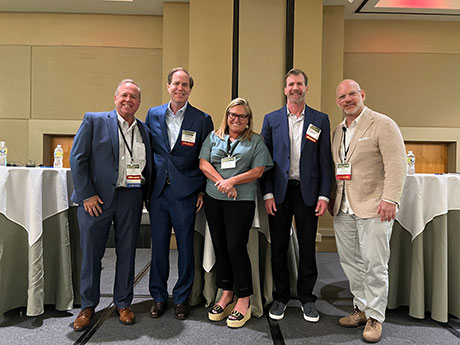ATLANTA — Delays in the arrival of building materials — everything from windows and roof trusses to microchips for electrical panels — is one of the biggest hurdles slowing down new seniors housing developments, according to Kristin Kutac Ward, CEO of Solvere Living.
Ward’s comments came during the ninth annual InterFace Seniors Housing conference. The event, which took place Aug. 17 at the Westin Buckhead in Atlanta, was hosted by France Media’s InterFace Conference Group and Seniors Housing Business and drew 324 attendees.
Joining Ward on the development panel was Tod Petty, vice chairman with Lloyd Jones Senior Living; Matthew Griffin, senior vice president, eastern states, with Griffin Living; and Jim Vogel, president of Solvida Development Group. Rick Shamberg, managing director of Scarp Ridge Capital, served as the moderator.
Despite the challenges in today’s building environment, there is pent-up demand and plenty of excitement regarding new seniors housing projects, said Ward. As baby boomers age, there will be a need for seniors housing care for about 50 million more people in the U.S., according to Shamberg.
There’s ample opportunity for developers to fill that void in housing. According to Petty, the need for seniors housing units will be most pronounced come 2030.
There’s a large market of baby boomers that won’t be able to afford the high price tags that often come with seniors housing communities. But on the flipside, there are high-end seniors who will pay more to receive greater services and amenities, explained Petty.
With today’s high construction costs, rents are on the rise. But there need to be additional services offered in order to justify rate hikes, argued Petty.
“There has to be a deliverable for the price increase,” he said. “We cannot just raise rents and call it a day.”
Adaptive reuse projects, while still costly, are one alternative to ground-up development. Vogel’s firm is converting a 160-room hotel in Lexington, Kentucky, into 135 units of assisted living and memory care.
“As a developer, our challenge is to change these equations that have limitations of construction costs and labor constraints,” said Vogel. “We’re able to take an existing asset and create an A+ product. We reverse-engineered our model into a price point that gets us about $500 to $1,000 less than market rents.”
Developers bring modern solutions to COVID-related challenges
Vogel said his firm is trying to shift labor constraints by using robots that help with dining services or transporting items such as linens or trash. Solvida is also zeroing in on certain technologies that utilize artificial intelligence to help predict issues for seniors housing residents like falls or urinary tract infections.
“There are all sorts of technologies coming out, especially in the memory care space,” said Griffin. “Our challenge is making sure the technology is sustainable.”
Developers also recognized the importance of outdoor space, particularly after the COVID-19 pandemic. Ward pointed to an example of a small seniors housing project in Chattanooga, Tennessee, that has the outdoor space equivalent to the size of a continuing care retirement community. “More balconies, outdoor space, access to the outdoors, fountains and connection to nature is the No. 1 biggest shift I’ve seen,” said Ward.
Another COVID-related change is air purification systems in communities. “That’s a huge selling point,” said Ward. “That’s one of the reasons we can command higher prices in California properties; their air purification systems are equivalent to that of a hospital. That’s important to a discerning buyer.”
For Griffin, one of the main COVID-related changes is larger units that feel more independent. Additions like cooktop stoves, in-unit washers and dryers, and balconies give residents more freedom and flexibility if they need to isolate in place during COVID outbreaks.
One of Griffin Living’s communities even has a lazy river. “The residents may not use it, but it’s there for them if they do want to use it,” said Griffin. “That’s a big difference; it’s not that they have to use it or will use it but that they can use it.”
At the end of the day, the number of amenities or high-end features a property receives depends on the market and the owner, emphasized Ward. “There are ways to get what people want now at different price points in different markets,” she said. “We just have to understand the owner’s goals, the market’s positioning and where the building fits within the market.”
— Kristin Hiller

